Triboelectric Nanogenerators
April 9, 2018
Winter in the
Northeastern United States, where
Tikalon is based, is responsible for more discomfort than
cold weather. The
low humidity permits the
discharge of huge
electrical sparks from
fingers to
switchplates. Rubbing of the dissimilar
materials of
socks,
slippers, or
shoes on
carpeting generates
electrical charges by the
triboelectric effect, and these charges flow to
ground through the grounded switchplate. I wrote about the triboelectric effect in two earlier articles (
Triboelectric Generators, July 25, 2012, and
Triboelectric Generators, February 8, 2016).
The triboelectric effect was known in
ancient Greece at least as early as 600
BC when
Thales of Miletus (c. 600 BC) observed that certain combinations of materials were better at spark production than others. In particular, the combination of
rabbit fur and amber was especially good. The word,
electron, comes from the
Greek word for amber, ηλεκτρον. Materials are better at spark production when they're widely separated in the triboelectric series, shown in the diagram below.
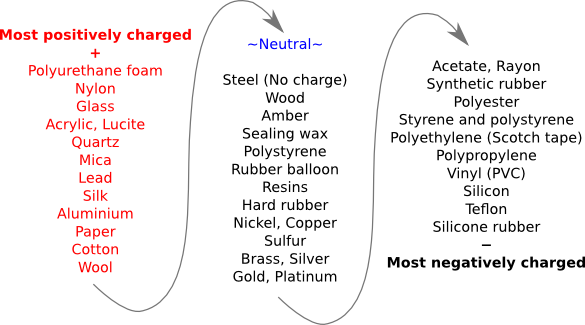
The triboelectric series. Items high on this list have a tendency to donate electrons to items lower on the list, and the separation of materials on this list indicates the intensity of the triboelectric effect. (Drawn using Inkscape from Wikipedia data.)
While the word triboelectric comes from the Greek verb for rubbing, tribo, (τριβω), rubbing is not required. It's just necessary for the dissimilar materials to contact each other, then separate.
Chemical bonds formed between the materials on contact will then separate charges when they're pulled apart, although rubbing helps by increasing the
contact area.
Engineers, of course, endeavor to make use of
physical effects, so the
British engineer,
James Wimshurst (1832-1903), built an
electrical generator called the
Wimshurst machine that produced
electricity by rubbing two disks together to generate charges collected by
metal patches and directed to
electrodes.
An improved version of this rubbing concept was devised by
Princeton University physics
professor,
Robert Van de Graaff(1901-1967), to generate the
high voltages needed to
accelerate particles in
nuclear physics experiments. His
eponymous Van de Graaff generator is very simple, as the figure shows.
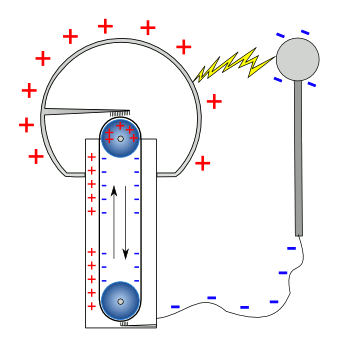
Diagram of a Van de Graaff generator
In this device, a pulley acts as one member of a triboelectric couple with an insulating belt.
Charge is transferred through small gaps between the belt and the brushes.
(Modified Wikimedia Commons image).)
Two years ago, I used the triboelectric effect to implement a
switch.[1] This switch used the rubbing of
Teflon® (PTFE) against
Kapton (
polyimide) to generate sufficient
voltage to toggle a
CMOS 4013 set-reset flip-flop. The power needed to trigger this
digital circuit is small, essentially five volts into a 3.3-
megohm load
resistance. Appealing to the
power formula,
P = V2/R, shows that the required power is of the order of ten
microwatts. This underscores one problem with triboelectric generators - Their output power is very small.
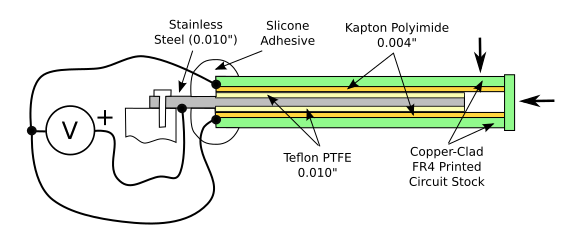
My triboelectric switch, as published in Electronic Design Magazine.[1] Voltage is generated by pushing in either of the directions shown, which causes sliding of the Kapton against the Teflon® (PTFE). The generated charges are collected by copper electrodes. (Created using Inkscape)
There is much electronic circuitry, however, that requires very little operating power. In some cases, a small amount of power, generated over a long period of time and stored, can be used to
transmit wireless data. In 2012, a
research team at the
Georgia Institute of Technology (Atlanta, GA) created a triboelectric generator from a sheet of polyester, an electron donor, rubbing against a sheet of polydimethylsiloxane, an electron acceptor.[2-3]
Triboelectric efficiency was enhanced in the Georgia Tech device by
micropatterning the surfaces (see photograph). Continually rubbing and separating the
micropatterned sheets generated a small alternating current of about 0.10 microamps per square centimeter at nearly 20 volts, giving a peak power of 2 microwatts per square centimeter.[2-3]
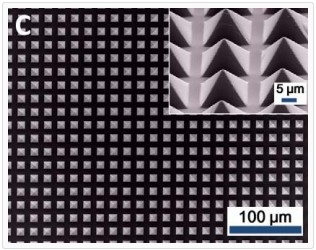
Micrograph of pyramidal patterns created in a polymer sheet for the Georgia Tech triboelectric generator.
(Georgia Tech image by Zhong Lin Wang).[2]
Polydimethylsiloxane has also been used to produce a triboelectric
nanogenerator by a research team with members from the
Chinese Academy of Sciences (Beijing, China) and the
State University of New York (Buffalo, New York).[4-5] This generator, based on a
crumpled gold film, gave a maximum voltage of 124.6 V, and a maximum current of 10.13 μA.[4] The maximum
power density achieved for this device, 0.22 mW/cm
2, is two
orders of magnitude greater than that of the Georgia Tech device.[4] This research is reported in a recent issue of
Nano Energy.[4]
The crumpled gold film makes the nanogenerator
bendable, a feature that's desireable for self-powered
wearable electronics.[4]
Reliability testing showed no obvious degradation in performance after a half-year's storage in an
ambient environment.[4] Says
Qiaoqiang Gan, associate professor of
electrical engineering at
Buffalo's School of Engineering and Applied Sciences and lead
author of the
paper,
"No one likes being tethered to a power outlet or lugging around a portable charger. The human body is an abundant source of energy. We thought: 'Why not harness it to produce our own power?'"[5]
The device structure is simple, consisting of polydimethylsiloxane sandwiched between two thin layers of gold.[5] One of the gold layers is initially stretched, so it crumples upon release, creating a nanostructured surface. An applied
force, as from a
finger bending, causes rubbing friction between the gold layers and the polydimethylsiloxane.[5] The triboelectricity produced by the rubbing produces charges at the gold layers. A 1.5
centimeter long by 1 centimeter wide device was able to flash a string of 48 red
LEDs.[5]
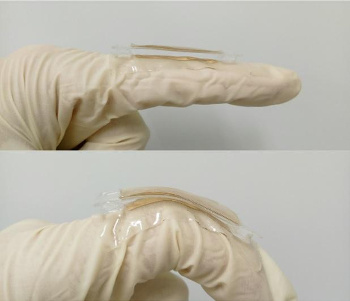
Bendable triboelectric nanogenerator.
Image - State University of New York at Buffalo/Nano Energy
Several things can make such triboelectric generators more useful. One of these is a way to store generated power, and the research team is working on a compatible
battery.[5] Another research team from the Chinese Academy of Sciences is working on
high voltage diodes with high
rectification ratio and high
breakdown voltage to aid in energy management of such generators.[6-7] The triboelectric nanogenerator research was supported by the
US National Science Foundation and various
Chinese agencies.[5]
References:
- Dev Gualtieri, "Simple, Novel Switch Exploits Triboelectric Effect," Electronic Design, June 3, 2016.
- John Toon, "Plastic Power: Triboelectric Generator Produces Electricity by Harnessing Frictional Forces Between Transparent Polymer Surfaces," Georgia Tech Press Release, July 9, 2012.
- Feng-Ru Fan, Long Lin, Guang Zhu, Wenzhuo Wu, Rui Zhang, and Zhong Lin Wang, "Transparent Triboelectric Nanogenerators and Self-Powered Pressure Sensors Based on Micropatterned Plastic Films," Nano Letters, vol. 12, no. 6 (June 13, 2012), pp. 3109-3114.
- Huamin Chen, Lin Bai, Tong Li, Chen Zhao, Jiushuang Zhang, Nan Zhang, Guofeng Song, Qiaoqiang Ganc, and Yun Xua, "Wearable and robust triboelectric nanogenerator based on crumpled gold films," Nano Energy, vol. 46 (April, 2018), pp. 73-80, https://doi.org/10.1016/j.nanoen.2018.01.032.
- Your gadget's next power supply? Your body, State University of New York, Buffalo, Press Release, February 9, 2018.
- Yonghui Zhang, Zengxia Mei, Tao Wang, Wenxing Huo, Shujuan Cui, Huili Liang, and Xiaolong Du, "Flexible transparent high-voltage diodes for energy management in wearable electronics," Nano Energy, vol. 40 (October, 2017), pp. 289-299, https://doi.org/10.1016/j.nanoen.2017.08.025.
- Yonghui Zhang, Zengxia Mei, Tao Wang, Wenxing Huo, Shujuan Cui, Huili Liang, and Xiaolong Du, "Flexible transparent high-voltage diodes for energy management in wearable electronics," arXiv September 20, 2017.
Linked Keywords: Winter; Northeastern United States; Tikalon; cold; weather; low humidity; electric discharge; electric spark; electrical sparks; finger; light switch; switchplate; material; sock; slipper; shoe; carpet; electric charge; electrical charge; triboelectric effect; electric ground; ancient Greece; Anno Domini; BC; Thales of Miletus (c. 600 BC); rabbit hair; rabbit fur; amber; electron; Greek language; Greek word; triboelectric series; intensity; Inkscape; Wikipedia; chemical bond; contact area; engineer; physics; physical; United Kingdom; British; James Wimshurst (1832-1903); electric generator; electrical generator; Wimshurst machine; electricity; metal; electrode; Princeton University; professor; Robert Van de Graaff(1901-1967); high voltage; particle accelerator; nuclear physics; experiment; eponymous; Van de Graaff generator; pulley; triboelectric couple; electrical insulator; insulating; brush; Wikimedia Commons; electric switch; polytetrafluoroethylene; Teflon® (PTFE); Kapton; polyimide; voltage; CMOS; 4000 series; 4013; set-reset flip-flop; digital electronics; digital circuit; ohm; megohm; electrical resistance; electric power; watt; microwatt; Electronic Design Magazine; copper; electrode; transmitter; transmit; radio; wireless; data; research; Georgia Institute of Technology (Atlanta, GA); polyester; energy conversion efficiency; micropatterning; micropatterned; alternating current; ampere; microamp; square meter; square centimeter; volt; micrograph; pyramid; pyramidal; polymer; Georgia Tech; nanogenerator; Chinese Academy of Sciences (Beijing, China); State University of New York (Buffalo, New York); crumpling; crumple; gold; power density; orders of magnitude; Nano Energy; bending stiffness; bendable; wearable computer; wearable electronics; reliability testing; ambient environment; Qiaoqiang Gan; electrical engineering; Buffalo's School of Engineering and Applied Sciences; author; scientific literature; paper; tether; tethered; AC power plugs and sockets; power outlet; battery charger; portable charger; human body; energy; force; finger; centimeter; light-emitting diode; LED; battery; diode; rectifier; rectification; ratio; breakdown voltage; US National Science Foundation; China; Chinese.